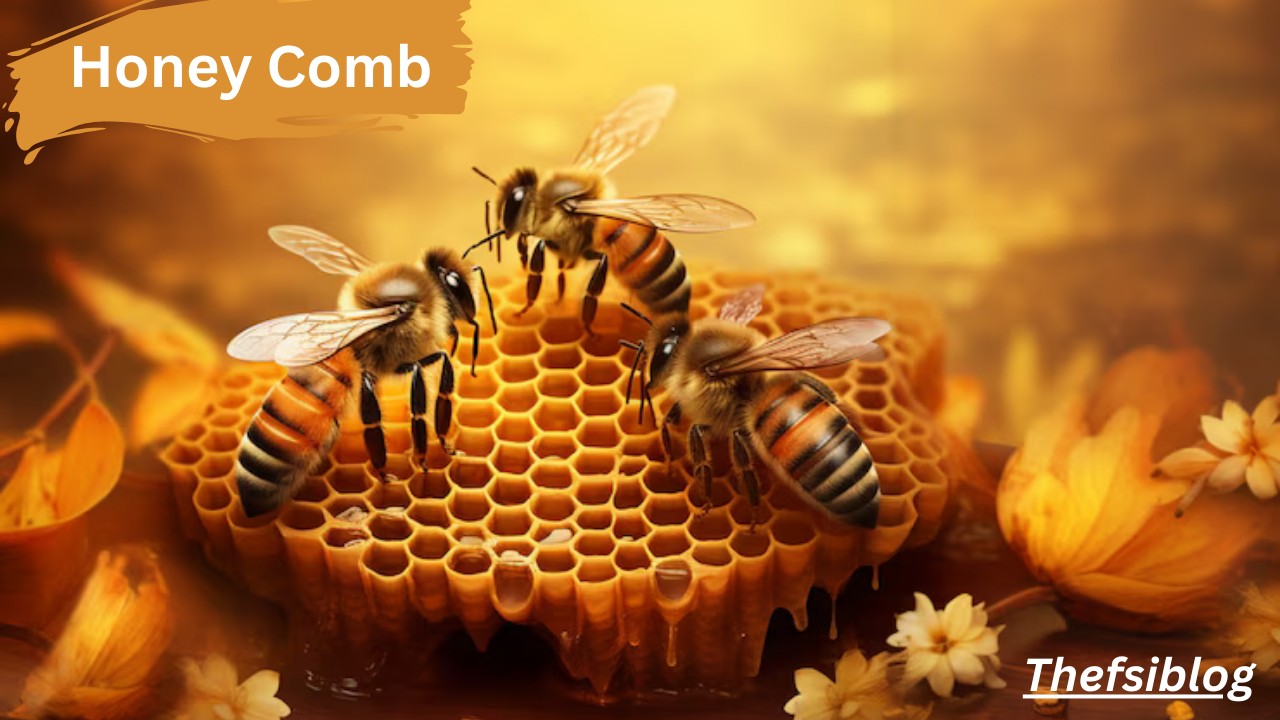Introduction
What Is honey comb?
honey comb is a natural product created by honeybees as a storage system for their honey and pollen. Made from beeswax, it consists of a series of hexagon-shaped cells, each filled with honey comb. This fascinating structure is not only crucial for the bees but also prized by humans for its unique taste and health benefits.
The Natural Formation of honey comb
Bees produce honey comb from beeswax, which they secrete from specialized glands. They meticulously build the hexagonal cells, which are both efficient in space and strong enough to hold the honey and pollen. This process is a remarkable feat of natural engineering, reflecting the bees’ instinctual prowess.
Table of Contents
Benefits of honey comb
Nutritional Value
honey comb is a nutrient-dense food that provides a range of vitamins, minerals, and antioxidants. It contains natural sugars, which offer quick energy, along with trace amounts of essential nutrients like vitamin B6, calcium, and iron.
Antioxidant Properties
The antioxidants in honey comb help combat oxidative stress and protect cells from damage caused by free radicals. This can contribute to overall health and may help prevent chronic diseases.
Antimicrobial Benefits
honey comb has natural antimicrobial properties due to the presence of hydrogen peroxide and other compounds. These properties can help fight off harmful bacteria and support a healthy immune system.
Skin Health Benefits
When applied topically, honey comb can soothe and moisturize the skin. Its natural humectant properties help retain moisture, making it beneficial for dry or irritated skin.
Uses of honey comb
Culinary Uses
honey comb is a delightful addition to various dishes. It can be enjoyed as a sweet treat on its own or used as a topping for yogurt, cheese, and baked goods. Its unique texture and flavor add a special touch to many recipes.
Medicinal Uses
Traditionally, honey comb has been used in natural remedies for its healing properties. It can be used to soothe coughs and sore throats, and its antimicrobial benefits make it useful for minor wounds and skin irritations.
Beauty and Skincare Applications
honey comb is a popular ingredient in natural skincare products. Its moisturizing and anti-inflammatory properties make it an excellent choice for homemade face masks and scrubs.
How honey comb Is Harvested
Beekeeping Basics
Beekeeping involves the careful management of honeybee colonies to produce honey and other bee products. Beekeepers monitor the health of the hives and ensure that the bees have enough resources to thrive.
Harvesting Techniques
Harvesting honey comb requires skill to avoid harming the bees or damaging the hive. Beekeepers use special tools to cut the honey comb from the frames and process it for consumption.
Ensuring Sustainable Practices
Sustainable beekeeping practices are essential for protecting bee populations and the environment. Beekeepers should prioritize ethical methods and avoid overharvesting to ensure the health of their colonies.
Types of honey com
Raw honey comb
Raw honey comb is the most natural form, straight from the hive without processing. It retains all of its natural enzymes, pollen, and nutrients.
Processed honey comb
Processed honey comb may be filtered or treated to remove impurities. While still beneficial, it may lose some of the natural characteristics of raw honey comb.
Infused honey comb
Infused honey comb is honey comb that has been flavored or combined with other ingredients, such as herbs or spices. This adds unique flavors and potential health benefits.
How to Incorporate honey comb into Your Diet
Adding honey comb to Breakfast
honey comb can be a delightful addition to your breakfast. Try it on toast, in oatmeal, or as a topping for pancakes and waffles.
Using honey comb in Baking
Incorporate honey comb into baked goods for added sweetness and texture. It works well in recipes for cakes, cookies, and muffins.
honey comb as a Natural Sweetener
Use honey comb as a natural alternative to refined sugars. It can be a healthier option for sweetening beverages, sauces, and dressings.
Storing and Preserving honey comb
Proper Storage Techniques
Store honey comb in a cool, dry place, away from direct sunlight. Keep it in an airtight container to maintain its freshness and prevent contamination.
Shelf Life and Expiry
honey comb has a long shelf life due to its low moisture content and natural preservatives. However, it’s best to use it within a year for optimal flavor and quality.
Signs of Spoilage
Signs of spoilage include mold growth, off odors, or a change in texture. If honey comb appears discolored or has an unusual smell, it’s best to discard it.
honey comb vs. Honey: What’s the Difference?
Comparing Raw Honey and honey comb
Raw honey is the liquid nectar collected by bees, while honey comb is the wax structure that houses the honey. honey comb contains honey as well as beeswax, which adds texture and additional nutrients.
Nutritional and Flavor Differences
honey comb offers a more complex flavor and texture compared to liquid honey. It provides the added benefits of beeswax, which contains beneficial compounds and a unique chewy texture.
Choosing Between Honey and honey comb
The choice between honey and honey comb depends on your preferences and intended use. For a natural sweetener, honey is convenient, while honey comb provides a unique texture and additional benefits.
Health Considerations and Allergies
Potential Allergic Reactions
Some individuals may be allergic to bee products, including honey comb. Symptoms can range from mild irritation to severe allergic reactions. Consult with a healthcare provider if you have concerns.
Health Benefits vs. Risks
While honey comb has many health benefits, it’s important to consume it in moderation due to its high sugar content. Balance its consumption with a healthy diet.
Consulting with a Healthcare Professional
If you have specific health conditions or concerns, consult with a healthcare professional before incorporating honey comb into your diet or skincare routine.
The Environmental Impact of honey comb
Sustainability of Beekeeping
Beekeeping can be sustainable when managed properly. Responsible practices help support bee populations and contribute to environmental health by promoting pollination.
Environmental Benefits of Bees
Bees play a crucial role in ecosystems by pollinating plants. Their activities support biodiversity and help maintain healthy ecosystems.
Ethical Considerations
Ethical beekeeping practices ensure that bees are treated well and their habitats are preserved. Supporting ethical beekeepers helps promote sustainability and environmental responsibility.
honey comb in Different Cultures
honey comb in Ancient Civilizations
honey comb has been valued since ancient times for its sweetness and medicinal properties. It was used in rituals, offerings, and as a natural remedy.
Modern Uses Around the World
In modern times, honey comb is enjoyed globally for its culinary and health benefits. Different cultures incorporate honey comb into traditional dishes and practices.
Cultural Significance
honey comb often holds cultural significance and is featured in celebrations and festivals. Its unique properties make it a symbol of natural sweetness and health.
DIY Recipes with honey comb
honey comb Granola Bars
Make homemade granola bars by adding honey comb pieces for a crunchy, sweet touch. Combine with nuts, seeds, and dried fruit for a nutritious snack.
honey comb-Infused Tea
Infuse honey comb into your tea for a natural sweetener with added health benefits. Simply add a small piece of honey comb to hot water and enjoy.
Homemade honey comb Candies
Create your own honey comb candies by combining honey comb with melted chocolate. These treats are a delicious way to enjoy the sweet flavors of honey comb.
The Science Behind honey comb Formation
The Role of Bees in honey comb Production
Bees produce honey comb to store honey and pollen, essential for their survival. The hexagonal cells are a result of the bees’ precise engineering and the properties of beeswax.
Chemical Composition of honey comb
honey comb consists of beeswax, honey, and pollen. The beeswax is rich in fatty acids and esters, while honey provides natural sugars and nutrients.
How honey comb Supports the Hive
honey comb supports the hive by providing storage for honey and pollen, which are vital for the colony’s nutrition and development. The structure also aids in temperature regulation within the hive.
Fun Facts About honey comb
Interesting Historical Facts
honey comb has been used since ancient times, with evidence found in archaeological sites and historical texts. It has been valued for its sweetness and medicinal properties.
Unique Uses of honey comb
honey comb has been used in various ways, from natural remedies to artistic creations. Its versatility makes it a fascinating product.
Lesser-Known Benefits
In addition to its well-known benefits, honey comb may offer lesser-known advantages, such as supporting oral health and improving digestion.
Conclusion
honey comb is a natural marvel with a range of benefits and uses. From its nutritional and medicinal properties to its unique texture and flavor, honey comb can enhance your diet and well-being. By understanding how to incorporate it into your life and supporting sustainable practices, you can enjoy all that this remarkable product has to offer.
FAQs
- What Is the Best Way to Eat honey comb?
Enjoy honey comb on its own, as a topping, or incorporated into recipes. It can be a delicious addition to breakfast or a sweet treat. - How Long Can honey comb Be Stored?
honey comb can be stored for up to a year when kept in an airtight container in a cool, dry place. - Are There Any Allergic Reactions to honey comb?
Some people may experience allergic reactions to honey comb. If you have known allergies or experience symptoms, consult a healthcare professional. - Can honey comb Be Used in Cooking?
Yes, honey comb can be used in cooking and baking to add natural sweetness and texture to various dishes. - How Is honey comb Different from Honey?
honey comb contains honey and beeswax, offering a unique texture and additional nutrients. Honey is the liquid nectar without the wax.
You can see lates updates on: thefsiblog



